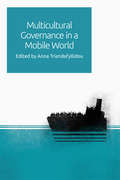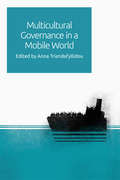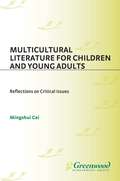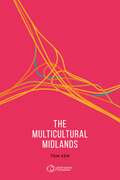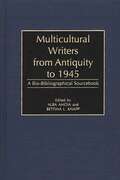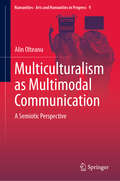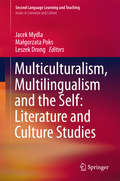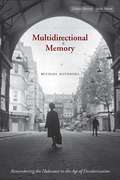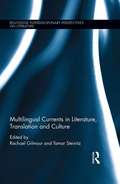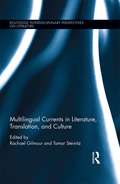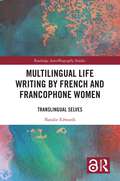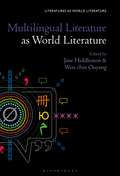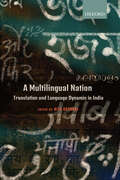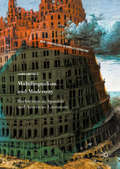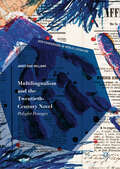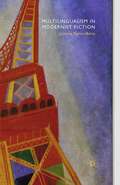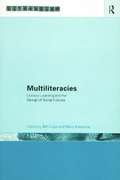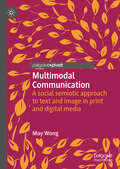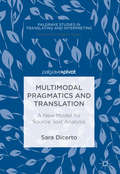- Table View
- List View
Multicultural Governance in a Mobile World
by Anna TriandafyllidouCollection of newly-commissioned essays tracing cutting-edge developments in children’s literature research
Multicultural Governance in a Mobile World (Edinburgh University Press)
by Anna TriandafyllidouReveals Virginia Woolf’s interest in Christianity, its ideas and cultural artefacts
Multicultural Literature for Children and Young Adults: Reflections on Critical Issues (Contributions to the Study of World Literature)
by Mingshui CaiThere is much discussion of multiculturalism in education. This is especially true of multicultural literature for children and young adults. The rise of multicultural literature is a political rather than a literary movement; it is a movement to claim space in literature and in education for historically marginalized social groups rather than one to renovate the craft of literature itself. Multicultural literature has been closely bound with the cause of multiculturalism in general and thus has been confronted with resistance from conservatives. This book discusses many of the controversial issues surrounding multicultural literature for children and young adults.The volume begins with a look at some of the foundational and theoretical issues related to multicultural literature. The second part of the book addresses issues related to the creation and critique of multicultural literature, including the authorship of such works and the role of the reader in determining whether or not a work is multicultural. The third looks at the place of multicultural literature in the education of children and young adults. Throughout its discussion, the book makes extensive references to a large body of multicultural fiction and provides a thorough review of research on this important topic.
The multicultural Midlands (Multicultural Textualities)
by Tom KewThe multicultural Midlands is a unique, interdisciplinary study of the literature, music and food that shape the region’s irrepressible, though often overlooked, cultural identity. It is the first of its kind to give serious critical attention to a part of the world which is frequently ignored by readers, critics and the culture industries. This book makes a claim for the importance of the Midlands and evidences this with nuanced close reading of a multitude of diverse texts spanning so-called ‘high’ to ‘low’ culture; from the Black Country’s ‘Desi Pubs’, to Leicester’s ‘McIndians’ Peri Peri (‘you’ve tried the cowboys, now try the Indians!’); Handsworth’s reggae roots to Adrian Mole’s diaries.
The multicultural Midlands (Multicultural Textualities)
by Tom KewThe multicultural Midlands is a unique, interdisciplinary study of the literature, music and food that shape the region’s irrepressible, though often overlooked, cultural identity. It is the first of its kind to give serious critical attention to a part of the world which is frequently ignored by readers, critics and the culture industries. This book makes a claim for the importance of the Midlands and evidences this with nuanced close reading of a multitude of diverse texts spanning so-called ‘high’ to ‘low’ culture; from the Black Country’s ‘Desi Pubs’, to Leicester’s ‘McIndians’ Peri Peri (‘you’ve tried the cowboys, now try the Indians!’); Handsworth’s reggae roots to Adrian Mole’s diaries.
Multicultural Writers from Antiquity to 1945: A Bio-Bibliographical Sourcebook
by Alba della Fazia Amoia Bettina Liebowitz KnappThe final decades of the 20th century have seen an explosion of interest in multiculturalism. But multiculturalism is more than an awareness of the different cultures comprising contemporary societies. For centuries, people from around the world have come in contact with cultures other than their own, and their exposure to multiple cultures has fostered their creativity and ability to make lasting contributions to civilization. The effects of multiculturalism are especially apparent in literature, since writers tend to be particularly aware of their environments and record their experiences.This reference includes alphabetically arranged entries for more than 100 world writers from antiquity to 1945, who were significantly influenced by cultures other than their own. Included are entries for major canonical Ancient and Modern writers of the Western and Eastern worlds. Each entry is written by an expert contributor and includes a brief biography, a discussion of multicultural themes and contexts, a summary of the writer's critical reception, and primary and secondary bibliographies. By illuminating the shaping influence of multiculturalism on these writers, the volume points to the lasting value of multiculturalism in the contemporary world.
Multiculturalism as Multimodal Communication: A Semiotic Perspective (Numanities - Arts and Humanities in Progress #9)
by Alin OlteanuThis highly readable book develops a numanistic, and specifically semiotic approach to multiculturalism. It reveals how semiotics provides fresh and valuable insights into multiculturalism: in contrast to the binary logic of dualistic philosophy, semiotic logic does not understand the value of truth in rigid terms of ‘true’ or ‘false’, ‘right’ or ‘wrong’ only. The value of truth resides in meaning, which is a dynamic, evolutionary phenomenon, rooted, nevertheless, in factuality.Drawing on recent developments in biosemiotics, the book presents a theoretical approach to multiculturalism, regarding the lives of people living in multicultural environments. Rather than analyzing political or economic phenomena, it offers a semiotic analysis of multiculturalism and discusses its educational implications. It also invites readers to regard learning as a phenomenon of ecological sign growth and to understand multiculturalism along the same lines. As such, it brings together the life and social sciences and the humanities in a unified perspective, in an approach fitting postmodernism.Developing a postmodern philosophy for contemporary non-experts, which allows distancing from political discourse in favor of a posthumanistic stand, where altruism is seen as an opportunity, not a threat, this book appeals to a wide readership, from scholars seeking state-of-the-art theories to general readers looking for a thought-provoking and enlightening read.
Multiculturalism, Multilingualism and the Self: Literature and Culture Studies (Second Language Learning and Teaching)
by Jacek Mydla Małgorzata Poks Leszek DrongThis edited collection explores the conjunction of multiculturalism and the self in literature and culture studies, and brings together essays by prominent researchers interested in literature and culture whose critical perspectives inform discussions of specific examples of multicultural contexts in which individuals and communities strive to maintain their identities. The book is divided into two major parts, the first of which comprises literary representations of multiculturalism and discussions of its impasses and impacts in fictional circumstances. In turn, the second part primarily focuses on culture at large and real-life consequences. Taken together, the two complementary parts offer an illuminating and well-rounded overview of representations of multiculturalism in literature and contemporary culture from a variety of critical perspectives.
Multidirectional Memory: Remembering the Holocaust in the Age of Decolonization (Cultural Memory in the Present)
by Michael RothbergMultidirectional Memory brings together Holocaust studies and postcolonial studies for the first time. Employing a comparative and interdisciplinary approach, the book makes a twofold argument about Holocaust memory in a global age by situating it in the unexpected context of decolonization. On the one hand, it demonstrates how the Holocaust has enabled the articulation of other histories of victimization at the same time that it has been declared "unique" among human-perpetrated horrors. On the other, it uncovers the more surprising and seldom acknowledged fact that public memory of the Holocaust emerged in part thanks to postwar events that seem at first to have little to do with it. In particular, Multidirectional Memory highlights how ongoing processes of decolonization and movements for civil rights in the Caribbean, Africa, Europe, the United States, and elsewhere unexpectedly galvanized memory of the Holocaust. Rothberg engages with both well-known and non-canonical intellectuals, writers, and filmmakers, including Hannah Arendt, Aimé Césaire, Charlotte Delbo, W.E.B. Du Bois, Marguerite Duras, Michael Haneke, Jean Rouch, and William Gardner Smith.
Multilingual Currents In Literature, Translation And Culture
by Rachael Gilmour Tamar SteinitzAt a time increasingly dominated by globalization, migration, and the clash between supranational and ultranational ideologies, the relationship between language and borders has become more complicated and, in many ways, more consequential than ever. This book shows how concepts of `language' and `multilingualism' look different when viewed from Belize, Lagos, or London, and asks how ideas about literature and literary form must be remade in a contemporary cultural marketplace that is both linguistically diverse and interconnected, even as it remains profoundly unequal. Bringing together scholars from the fields of literary studies, applied linguistics, publishing, and translation studies, the volume investigates how multilingual realities shape not only the practice of writing but also modes of literary and cultural production. Chapters explore examples of literary multilingualism and their relationship to the institutions of publishing, translation, and canon-formation. They consider how literature can be read in relation to other multilingual and translational forms of contemporary cultural circulation and what new interpretative strategies such developments demand. In tracing the multilingual currents running across a globalized world, this book will appeal to the growing international readership at the intersections of comparative literature, world literature, postcolonial studies, literary theory and criticism, and translation studies.
Multilingual Currents in Literature, Translation and Culture (Routledge Interdisciplinary Perspectives on Literature)
by Rachael Gilmour Tamar SteinitzAt a time increasingly dominated by globalization, migration, and the clash between supranational and ultranational ideologies, the relationship between language and borders has become more complicated and, in many ways, more consequential than ever. This book shows how concepts of ‘language’ and ‘multilingualism’ look different when viewed from Belize, Lagos, or London, and asks how ideas about literature and literary form must be remade in a contemporary cultural marketplace that is both linguistically diverse and interconnected, even as it remains profoundly unequal. Bringing together scholars from the fields of literary studies, applied linguistics, publishing, and translation studies, the volume investigates how multilingual realities shape not only the practice of writing but also modes of literary and cultural production. Chapters explore examples of literary multilingualism and their relationship to the institutions of publishing, translation, and canon-formation. They consider how literature can be read in relation to other multilingual and translational forms of contemporary cultural circulation and what new interpretative strategies such developments demand. In tracing the multilingual currents running across a globalized world, this book will appeal to the growing international readership at the intersections of comparative literature, world literature, postcolonial studies, literary theory and criticism, and translation studies.
Multilingual Currents in Literature, Translation and Culture (Routledge Interdisciplinary Perspectives on Literature)
At a time increasingly dominated by globalization, migration, and the clash between supranational and ultranational ideologies, the relationship between language and borders has become more complicated and, in many ways, more consequential than ever. This book shows how concepts of ‘language’ and ‘multilingualism’ look different when viewed from Belize, Lagos, or London, and asks how ideas about literature and literary form must be remade in a contemporary cultural marketplace that is both linguistically diverse and interconnected, even as it remains profoundly unequal. Bringing together scholars from the fields of literary studies, applied linguistics, publishing, and translation studies, the volume investigates how multilingual realities shape not only the practice of writing but also modes of literary and cultural production. Chapters explore examples of literary multilingualism and their relationship to the institutions of publishing, translation, and canon-formation. They consider how literature can be read in relation to other multilingual and translational forms of contemporary cultural circulation and what new interpretative strategies such developments demand. In tracing the multilingual currents running across a globalized world, this book will appeal to the growing international readership at the intersections of comparative literature, world literature, postcolonial studies, literary theory and criticism, and translation studies.
Multilingual Life Writing by French and Francophone Women: Translingual Selves (Routledge Auto/Biography Studies)
by Natalie EdwardsThis volume examines the ways in which multilingual women authors incorporate several languages into their life writing. It compares the work of six contemporary authors who write predominantly in French. It analyses the narrative strategies they develop to incorporate more than one language into their life writing: French and English, French and Creole, or French and German, for example. The book demonstrates how women writers transform languages to invent new linguistic formations and how they create new formulations of subjectivity within their self-narrative. It intervenes in current debates over global literature, national literatures and translingual and transnational writing, which constitute major areas of research in literary and cultural studies. It also contributes to debates in linguistics through its theoretical framework of translanguaging. It argues that multilingual authors create new paradigms for life writing and that they question our understanding of categories such as "French literature."
Multilingual Life Writing by French and Francophone Women: Translingual Selves (Routledge Auto/Biography Studies)
by Natalie EdwardsThis volume examines the ways in which multilingual women authors incorporate several languages into their life writing. It compares the work of six contemporary authors who write predominantly in French. It analyses the narrative strategies they develop to incorporate more than one language into their life writing: French and English, French and Creole, or French and German, for example. The book demonstrates how women writers transform languages to invent new linguistic formations and how they create new formulations of subjectivity within their self-narrative. It intervenes in current debates over global literature, national literatures and translingual and transnational writing, which constitute major areas of research in literary and cultural studies. It also contributes to debates in linguistics through its theoretical framework of translanguaging. It argues that multilingual authors create new paradigms for life writing and that they question our understanding of categories such as "French literature."
Multilingual Literature as World Literature (Literatures as World Literature)
by Jane Hiddleston and Wen-chin OuyangMultilingual Literature as World Literature examines and adjusts current theories and practices of world literature, particularly the conceptions of world, global and local, reflecting on the ways that multilingualism opens up the borders of language, nation and genre, and makes visible different modes of circulation across languages, nations, media and cultures.The contributors to Multilingual Literature as World Literature examine four major areas of critical research. First, by looking at how engaging with multilingualism as a mode of reading makes visible the multiple pathways of circulation, including as aesthetics or poetics emerging in the literary world when languages come into contact with each other. Second, by exploring how politics and ethics contribute to shaping multilingual texts at a particular time and place, with a focus on the local as a site for the interrogation of global concerns and a call for diversity. Third, by engaging with translation and untranslatability in order to consider the ways in which ideas and concepts elude capture in one language but must be read comparatively across multiple languages. And finally, by proposing a new vision for linguistic creativity beyond the binary structure of monolingualism versus multilingualism.
Multilingual Literature as World Literature (Literatures as World Literature)
Multilingual Literature as World Literature examines and adjusts current theories and practices of world literature, particularly the conceptions of world, global and local, reflecting on the ways that multilingualism opens up the borders of language, nation and genre, and makes visible different modes of circulation across languages, nations, media and cultures.The contributors to Multilingual Literature as World Literature examine four major areas of critical research. First, by looking at how engaging with multilingualism as a mode of reading makes visible the multiple pathways of circulation, including as aesthetics or poetics emerging in the literary world when languages come into contact with each other. Second, by exploring how politics and ethics contribute to shaping multilingual texts at a particular time and place, with a focus on the local as a site for the interrogation of global concerns and a call for diversity. Third, by engaging with translation and untranslatability in order to consider the ways in which ideas and concepts elude capture in one language but must be read comparatively across multiple languages. And finally, by proposing a new vision for linguistic creativity beyond the binary structure of monolingualism versus multilingualism.
A Multilingual Nation: Translation and Language Dynamic in India
by Rita KothariHow does India live through the oddity of being both a nation and multilingual? Is multilingualism in India to be understood as a neatly laid set of discrete languages or a criss-crossing of languages that runs through every source language and text? The questions take us to reviewing what is meant by language, multilingualism, and translation. Challenging these institutions, A Multilingual Nation illustrates how the received notions of translation discipline do not apply to India. It provocatively argues that translation is not a ‘solution’ to the allegedly chaotic situation of many languages, rather it is its inherent and inalienable part. An unusual and unorthodox collection of essays by leading thinkers and writers, new and young researchers, it establishes the all-pervasive nature of translation in every sphere in India and reverses the assumptions of the steady nature of language, its definition, and the peculiar fragility that is revealed in the process of translation.
Multilingualism and Modernity: Barbarisms in Spanish and American Literature
by Laura LonsdaleThis book explores multilingualism as an imaginative articulation of the experience of modernity in twentieth-century Spanish and American literature. It argues that while individual multilingual practices are highly singular, literary multilingualism exceeds the conventional bounds of modernism to become emblematic of the modern age. The book explores the confluence of multilingualism and modernity in the theme of barbarism, examining the significance of this theme to the relationship between language and modernity in the Spanish-speaking world, and the work of five authors in particular. These authors – Ramón del Valle-Inclán, Ernest Hemingway, José María Arguedas, Jorge Semprún and Juan Goytisolo – explore the stylistic and conceptual potential of the interaction between languages, including Spanish, French, English, Galician, Quechua and Arabic, their work reflecting the eclecticism of literary multilingualism while revealing its significance as a mode of response to modernity.
Multilingualism and Modernity: Barbarisms in Spanish and American Literature
by Laura LonsdaleThis book explores multilingualism as an imaginative articulation of the experience of modernity in twentieth-century Spanish and American literature. It argues that while individual multilingual practices are highly singular, literary multilingualism exceeds the conventional bounds of modernism to become emblematic of the modern age. The book explores the confluence of multilingualism and modernity in the theme of barbarism, examining the significance of this theme to the relationship between language and modernity in the Spanish-speaking world, and the work of five authors in particular. These authors – Ramón del Valle-Inclán, Ernest Hemingway, José María Arguedas, Jorge Semprún and Juan Goytisolo – explore the stylistic and conceptual potential of the interaction between languages, including Spanish, French, English, Galician, Quechua and Arabic, their work reflecting the eclecticism of literary multilingualism while revealing its significance as a mode of response to modernity.
Multilingualism and the Twentieth-Century Novel: Polyglot Passages (New Comparisons in World Literature)
by James Reay WilliamsThis book argues that the Anglophone novel in the twentieth century is, in fact, always multilingual. Rooting its analysis in modern Europe and the Caribbean, it recognises that monolingualism, not multilingualism, is a historical and global rarity, and argues that this fact must inform our study of the novel, even when it remains notionally Anglophone. Drawing principally upon four authors – Joseph Conrad, Jean Rhys, Wilson Harris and Junot Díaz – this study argues that a close engagement with the novel reveals a series of ways to apprehend, depict and theorise various kinds of language diversity. In so doing, it reveals the presence of the multilingual as a powerful shaping force for the direction of the novel from 1900 to the present day which cuts across and complicates current understandings of modernist, postcolonial and global literatures.
Multilingualism in Modernist Fiction
by J. Taylor-BattyThis new study argues that modernist literature is characterised by a 'multilingual turn'. Examining the use of different languages in the fiction of a range of writers, including Lawrence, Richardson, Mansfield, Rhys, Joyce and Beckett, Taylor-Batty demonstrates the centrality of linguistic plurality to modernist forms of defamiliarisation.
Multiliteracies: Literacy Learning And Design Of Social Futures (Literacies)
by Bill Cope Mary KalantzisMultiliteracies considers the future of literacy teaching in the context of the rapidly changing English language. Questions are raised about what constitutes appropriate literacy teaching in today's world: a world that is both a global village yet one which local diversity is increasingly important. This is a coherent and accessible overview of the work of the New London Group, with well-known international contributors bringing together their varying national experiences and differences of theoretical and political emphasis. The essays deal with issues such as: the fundamental premises of literacy pedagogy the effects of technological change multilingualism and cultual diversity social futures and their implications on language teaching. The book concludes with case studies of attempts to put the theories into practice and thereby provides a basis for dialogue with fellow educators around the world.
Multiliteracies: Lit Learning (Literacies)
by Bill Cope Mary KalantzisMultiliteracies considers the future of literacy teaching in the context of the rapidly changing English language. Questions are raised about what constitutes appropriate literacy teaching in today's world: a world that is both a global village yet one which local diversity is increasingly important. This is a coherent and accessible overview of the work of the New London Group, with well-known international contributors bringing together their varying national experiences and differences of theoretical and political emphasis. The essays deal with issues such as: the fundamental premises of literacy pedagogy the effects of technological change multilingualism and cultual diversity social futures and their implications on language teaching. The book concludes with case studies of attempts to put the theories into practice and thereby provides a basis for dialogue with fellow educators around the world.
Multimodal Communication: A social semiotic approach to text and image in print and digital media
by May WongThis book draws on visual data, ranging from advertisements to postage stamps to digital personal photography, to offer a complex interpretation of the different social functions realised by these texts as semiotic artefacts. Framed within the media environment of the city of Hong Kong, the study demonstrates the importance of social context to meaning making and social semiotic multimodal analysis. This book will be of interest to readers in the arts, humanities and social sciences, particularly within the fields of semiotics, visual studies, design studies, media and cultural studies, anthropology and sociology.
Multimodal Pragmatics and Translation: A New Model for Source Text Analysis
by Sara DicertoThis book proposes a new model for the translation-oriented analysis of multimodal source texts. The author guides the reader through semiotics, multimodality, pragmatics and translation studies on a quest for the meaning-making mechanics of texts that combine images and words. She openly challenges the traditional view that sees translators focusing their attention mostly on the linguistic aspect of source material in their work. The central theoretical pivot around which the analytical model revolves is that multimodal texts communicate through individual images and linguistic units, as well as through the interaction among textual resources and the text's interaction with its context of reference. This three-dimensional view offers a holistic understanding of multimodal texts and their potential translation issues to help translators improve the way they communicate multimodally across languages and cultures. This book will appeal to researchers in the fields of translation studies, multimodality and pragmatics.
